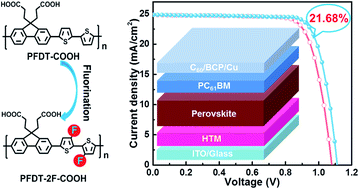Achieving over 21% efficiency in inverted perovskite solar cells by fluorinating a dopant-free hole transporting material†
Abstract
Hole transporting materials (HTMs) play a critical role in ameliorating the performance of perovskite solar cells (PSCs). Dedicated HTMs can improve not only the hole extraction and efficiency but also the stability. Herein, PFDT-COOH and its fluorinated derivative, PFDT-2F-COOH, are introduced as dopant-free HTMs for inverted PSCs. Compared to PFDT-COOH, PFDT-2F-COOH exhibits a deeper highest occupied molecular orbital (HOMO) level, a higher work function on indium tin oxide electrodes, and an elevated built-in potential in the device. The PFDT-COOH device based on FA1−xMAxPbI3 mixed-cation perovskite exhibits a champion power conversion efficiency (PCE) of 20.64%, while the PFDT-2F-COOH device exhibits a champion PCE of 21.68%, which is close to the highest value (21.7%) attained in inverted single-junction PSCs. The elevated efficiency is attributed to reduction of carrier recombination and enhancement of carrier extraction via the fluorination strategy. In addition, the two devices also show excellent operational and thermal stabilities. Therefore, our work offers a feasible strategy for preparing high efficiency and stable inverted PSCs.



 Please wait while we load your content...
Please wait while we load your content...